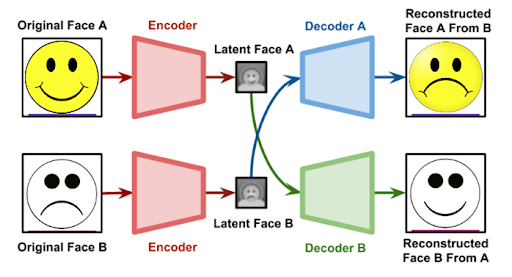Introduction: In the rapidly advancing realm of artificial intelligence, one technology has garnered both fascination and concern – Deepfake. A portmanteau of “deep learning” and “fake,” Deepfake technology has revolutionized the way we perceive visual and auditory content. This article aims to unravel the intricacies of Deepfake technology, exploring its origins, applications, impact on society, and the ethical considerations it brings to the forefront.
Origins and Evolution: Deepfake technology originated from the field of deep learning, specifically from the development of Generative Adversarial Networks (GANs). GANs consist of two neural networks – a generator and a discriminator – engaged in a continuous process of creating and evaluating content. The technology has evolved to a point where it can convincingly alter or generate content, including images, videos, and audio recordings.
How does a deepfake technology work?
Deepfake technology, like other deep-learning algorithms, relies on neural networks, essentially a software construction aiming to emulate the human brain’s functioning. The process involves source data samples, an encoder, and a decoder. A universal encoder analyses and compares key features of the source data, which can be an image, video, text, or audio file. The data are then broken down to a lower-dimensional latent space, and the encoder is trained to identify patterns. The decoder, a trained algorithm, utilizes the specifications of the target to compare and contrast the two images, superimposing the traits of the source onto the target image, resulting in forged data.
The pivotal architecture enabling the precision of deepfake technology is the generative adversarial network (GAN), a part of the decoder. Typically, the encoder extracts latent features, like faces, from images, while the decoder reconstructs faces. When creating deepfakes by swapping faces between the target and source images, two pairs of decoders and encoders are required. Each is first trained on the source and then on the target image. GANs stand out due to the collaborative operation of the generator and discriminator.
The generator creates a new image from the latent representation of the source data. Meanwhile, the discriminator distinguishes between the newly generated and the original real data, determining whether the image is authentic. Through adversarial learning and optimization of their goals based on their loss function, the generator and discriminator continually enhance accuracy. The power of GANs lies in their ability to create new datasets with distribution and statistics similar to the main dataset used for training. The discriminator learns about the data distribution, resulting in a model capable of outputting new, realistic samples. The continuous performance improvements and vector arithmetic in latent space contribute to the technology’s impressive applicability.
Deepfakes operate by analysing vast datasets of a target individual’s images or recordings. The deep learning model learns the intricacies of the target’s facial expressions, voice patterns, and other distinctive features. Once trained, the model can generate highly realistic content that mimics the target’s behaviour.

Applications of Deepfake Technology:
- Entertainment Industry: Deepfake technology has found a niche in the entertainment industry, enabling filmmakers to recreate scenes with historical figures or bring characters back to life. While offering creative possibilities, this application raises questions about the ethical use of deceased actors’ likenesses.
- Political Manipulation: The potential for using Deepfakes in political contexts has raised alarms. Deepfake videos of public figures saying or doing things they never did could be weaponized for disinformation, leading to serious implications for public trust and democracy.
- Education and Training: In a positive light, Deepfake technology has been explored for educational purposes, allowing for realistic simulations and training scenarios. This application could be particularly valuable in fields such as healthcare and emergency response training.
Impact on Society:
- Erosion of Trust: The rise of Deepfake technology contributes to the erosion of trust in visual and auditory content. As realistic synthetic media becomes more prevalent, individuals may question the authenticity of what they see and hear.
- Potential for Harassment: Deepfake technology raises concerns about its potential for misuse, especially in the context of personal relationships or public figures. Malicious use of Deepfakes can lead to harassment, reputation damage, or the spread of false narratives.
Conclusion: Deepfake technology presents a fascinating yet complex landscape that demands careful consideration. As society grapples with the ethical implications and potential risks, a proactive approach to regulation and awareness is essential to navigate the evolving impact of Deepfake technology responsibly. Balancing innovation with ethical considerations will be pivotal in shaping a future where Deepfake technology is harnessed for positive applications while safeguarding the integrity of truth and trust in our digital world.

Author:
Ms. Neelam Rawat
Associate Professor, Department of Computer Applications, KIET Group of Institutions
